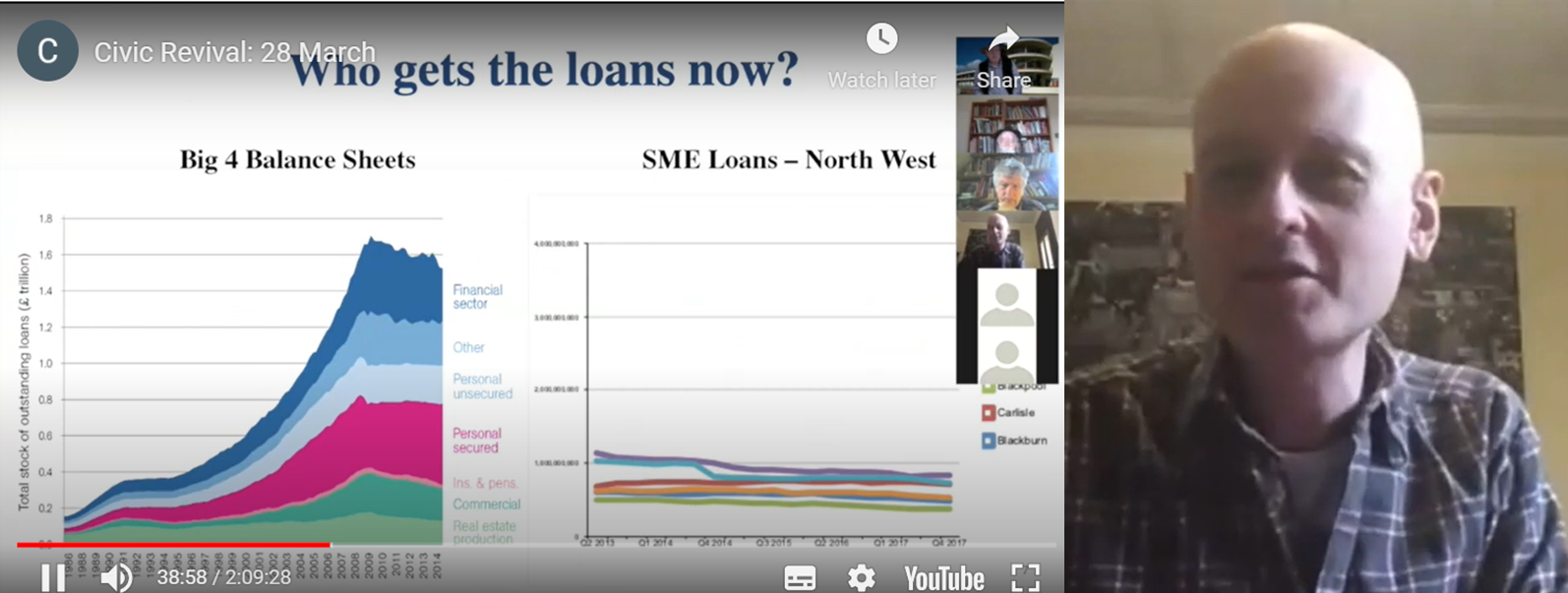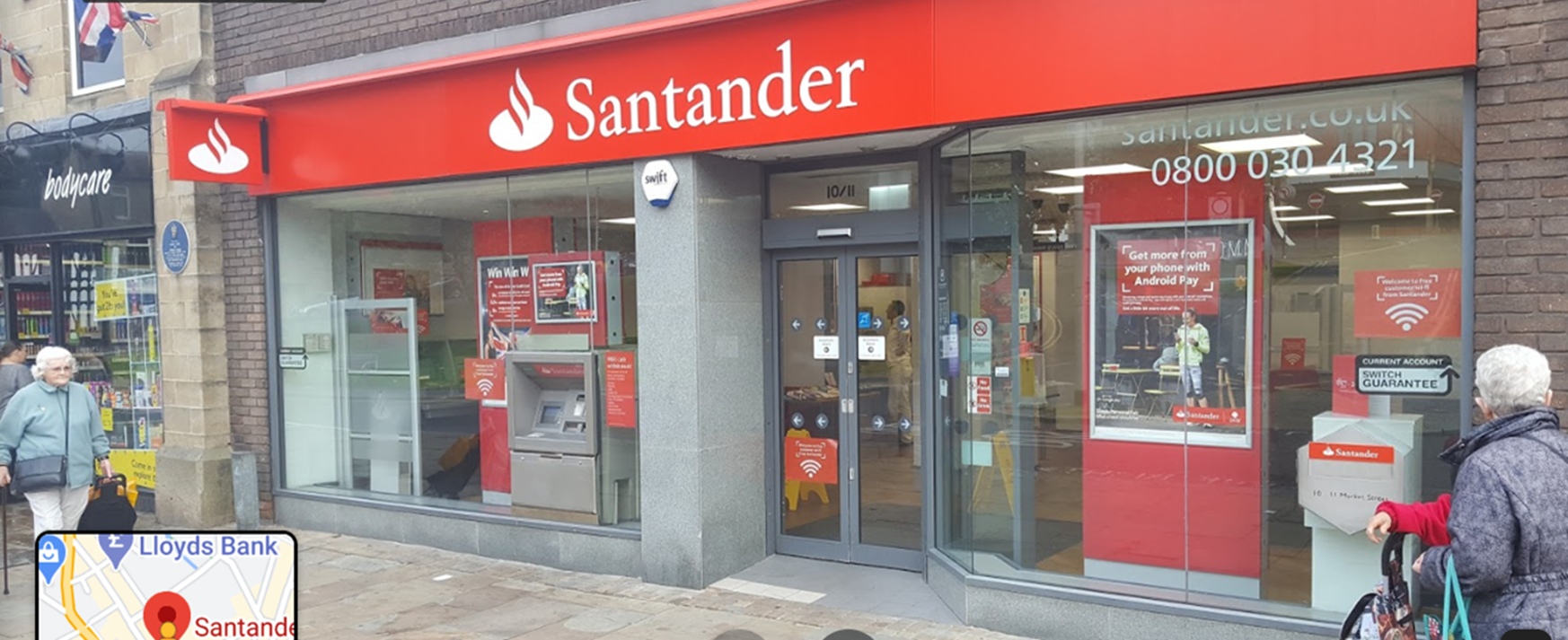Richard Walker reflects on the disappearance of high street anchor institutions with an unlikely lament for the lost Abbey habit
Who will lament the demise of 110 branches of the not particularly loveable Santander Bank UK, as announced on 25 March? Well, if nobody else will, Civic Revival will. The garish red-branded branches of Santander and its predecessor Abbey National, looking more like shops or showrooms than traditional banks, were a taken-for-granted staple feature of any ‘clone town’ high street of the England of the past 30 years. Everybody of a certain age can sing along to the jingle “Get the Abbey habit, with Abbey Na-aa-tio-nal!” in the same way our forefathers could sing along to an old folk song.
The lament is not for Santander per se, but for 110 mostly modest town centres, high streets and suburban parades from Arnold, Notts to Winton, Dorset. The closure of their bank branch deals an additional blow to all of these places at a difficult time. The new ‘post-clone town’ high street may be waiting to be born, but there are no guarantees that every high street is going to survive the transition process.
The branches to be closed by Santander are listed in full at the foot of this piece. What is immediately striking is just how many (what we might call) 'third tier' town and district centres there are. The 110 are just a tiny fraction of several thousand. England is a small country, but it contains so much detail.
However, this essay is also a lament for something else that is related to banking: the imminent wider death of branch banking as a phenomenon, the end of era for a key anchor institution of every high street in the country. Anybody who has been into a bank in the last few years – including before the coronavirus crisis – has experienced the depressing phenomenon of the staff reciting a script about “did you know you can do this online?”, which might as well be them saying: “please put me out of a job, so that my board can pay themselves another few million quid per year”.
Santander expects to make 640 redundancies from this current exercise. Many more thousands will follow, as the truth is that online banking really is far more efficient, and the human bank clerk really is obsolete. Nevertheless, online only will never be for everyone. The underlying reason for writing this piece was concern for the future of our high streets and town centres, but the trigger for it was seeing the long, socially-distanced queues of people stretching down the street, waiting to get into the Kilburn High Road branches of banks including Santander on the afternoon of Maundy Thursday, 2021: ordinary people – pensioners, migrant workers, others - trying to get their banking business done before the Easter holidays, who prefer to do it with human beings in a branch than on an app. People like me.
The piece ends on a note of hope: Civic Revival’s Empowering Our Communities online event on Sunday 28 March heard from Matthew Brown, the leader of Preston City Council, that mutually-owned local and regional banks, rooted in their places and designed to be supportive of their local economies, are on the verge of making a comeback. Also at the event, Caoimhe O'Gorman of Hastings Commons and Frances Northrop of Atmos Totnes told us how they are paving the way for mutually-owned business premises, homes and community spaces. It is only through such community empowerment and locally-led solutions that these 110 places stand the chance of a brighter, more congenial future.

Emerging from hibernation
Walker’s Wanderings has been quiet for the last six months for the reason that there haven’t been any wanderings: the long winter coronavirus lockdowns put paid to that. Now, however, there is an enticing prospect of emerging from hibernation into a spring of progressive ‘unlockdown’. Let’s hope it isn’t a mirage.
It’s pleasing to imagine that if I wanted to travel from Arnold to Winton this summer, calling at 108 other places in-between, I could. However, as it was last summer, the pleasure of the thought of being unlocked and free to roam is strongly tinged with trepidation: how much damage additional to the loss of their Santander will these 110 high streets, town and city centres have sustained? How many of the historic, interesting, independent businesses, shops, pubs and cafes, that make travelling to different places across the country a fun thing to do, will have survived? The prospects do not in all honesty look good: a stroll down any high street suggests there are a lot of businesses out there that do not look like they will be opening up again any time soon.
What might be the contrast with last summer? Many small retailers have learned to survive by becoming takeaway/delivery businesses. At the same time, consumers have learned how to get what they want by the internet and have got further out of practice in the art of being out and about. Many of us have become to a greater or lesser degree agoraphobic – in the literal translation from the Greek, frightened of going to the market square.
On the other hand, there is a school of thought that all this may be good news for the smaller town centres and suburban parades – if, post-Covid, people are going to work from home more and commute to the big city less, then the daytime population of the suburbs will increase, and – the argument goes - trade in the district centres will increase. The “15 minute city” and the renaissance of the suburb as urban village is at hand. Is this remotely likely? We shall see. Whatever happens, Civic Revival will try to fill the gaps in the mainstream coverage of the situation and provide a view of what is going on that is not otherwise being told.
The roll call of the doomed
Take another look at the list of the Santander branches to be closed in June, July and August. Their regional distribution is a product of how Santander UK’s branch empire was built up, the story of which is told further down this page. No less than 40 of the branches to be closed are in London, in places from Balham to West Wickham. 15 are in the North West, in small towns from Bramhall to Liscard Village, Wallasey; 17 in the South East, from Banstead to Windsor. In the Midlands, Leicestershire is particularly badly hit, with branches closing in Ashby-de-la-Zouch, Blaby, Hinckley, Leicester Horsefair Street, Leicester Narborough Road, Oadby and Syston: this is the legacy of Santander’s takeover of the former Alliance & Leicester Building Society.
On the list of 110, no fewer than 27 branches are located on a street actually called High Street. None of these are in Lancashire or Yorkshire, where the street name ‘High Street’ is not really a thing – here the closed branches are on streets with names like Market Street (Darwen), Commercial Street (Brighouse), Town Street (Horsforth), Main Street (Bingley), Northgate (Dewsbury).
I thought I was something of a place nerd, but there are places on the list I had never heard of before, including Winton – a suburb of Bournemouth lying one mile north of the main town centre. About 20 of the branches are in places I can claim know pretty well, and a further 15 in places I can say I have visited and could tell a story about – in fact, that is precisely what I do below (don’t panic, there are less than 35 stories). The remainder are a mix of places I may have passed through but cannot say I know, and places I have never been to at all. Take a look down the list and try the game yourself.
Personal memories of a collector of places
Lytham St Annes is where my grandparents used to take us on the train from Bolton to go to the seaside as kids. Walkden is where I used to venture to on the bus as a teenager to visit the Unit 4 Cinema. As a town planning student, I chose Headington shops, Oxford, as the subject of an urban design assignment. The first rented place I moved to in London was behind the bus garage off Putney High Street. In my first job, 6.30am starts on Shepherds Bush Green and Chiswick High Road are, in retrospect, happy memories. I once hitched a ride down Leytonstone High Road on a cart pulled by a white ox and driven by a robed Hare Krishna devotee. The queue of traffic behind the cart was a mile long.
Later, the first place my kids went to paddle in the sea as toddlers was Leigh-on-Sea (it’s not the sea by the way, it’s the rather muddy Thames estuary). The Urban Repairs Club, precursor of Civic Revival, made memorable expeditions to Darwen, Surbiton, Margate and Moorgate. Mundane places for a mundane life? Maybe, but I’ve always enjoyed it.
There are places on the list that I feel like I ought to know better, but don’t, and would like to put that right; names to conjure with: Poulton-le-Fylde, Chorlton-cum-Hardy, Chester-le-Street.
Every place matters to somebody
Some places on the doomed list we can expect will be OK despite the demise of their Santander branch; indeed, they may liberate an in-demand shop unit for a more interesting use. Examples include well-to-do Chiswick or Gosforth, or much-gentrified Balham or Chorlton-cum-Hardy. But these are very much the minority - so many of the 110 places are on their uppers. I worry about Dewsbury, Brighouse, Darwen: places that have got all the ingredients to be very content, but aren’t quite at the moment.
I even worry about the places I don’t know and may never visit. Every one of these places has its own long history and its own community for whom the place is meaningful and who want to see it do well. In the public debate over the future of the high street, often the spotlight is on the larger towns and cities rather than this smaller type of place which is so numerous. Do we really want to board all this history and community up, and let it all rot?
El Imperio de Santander
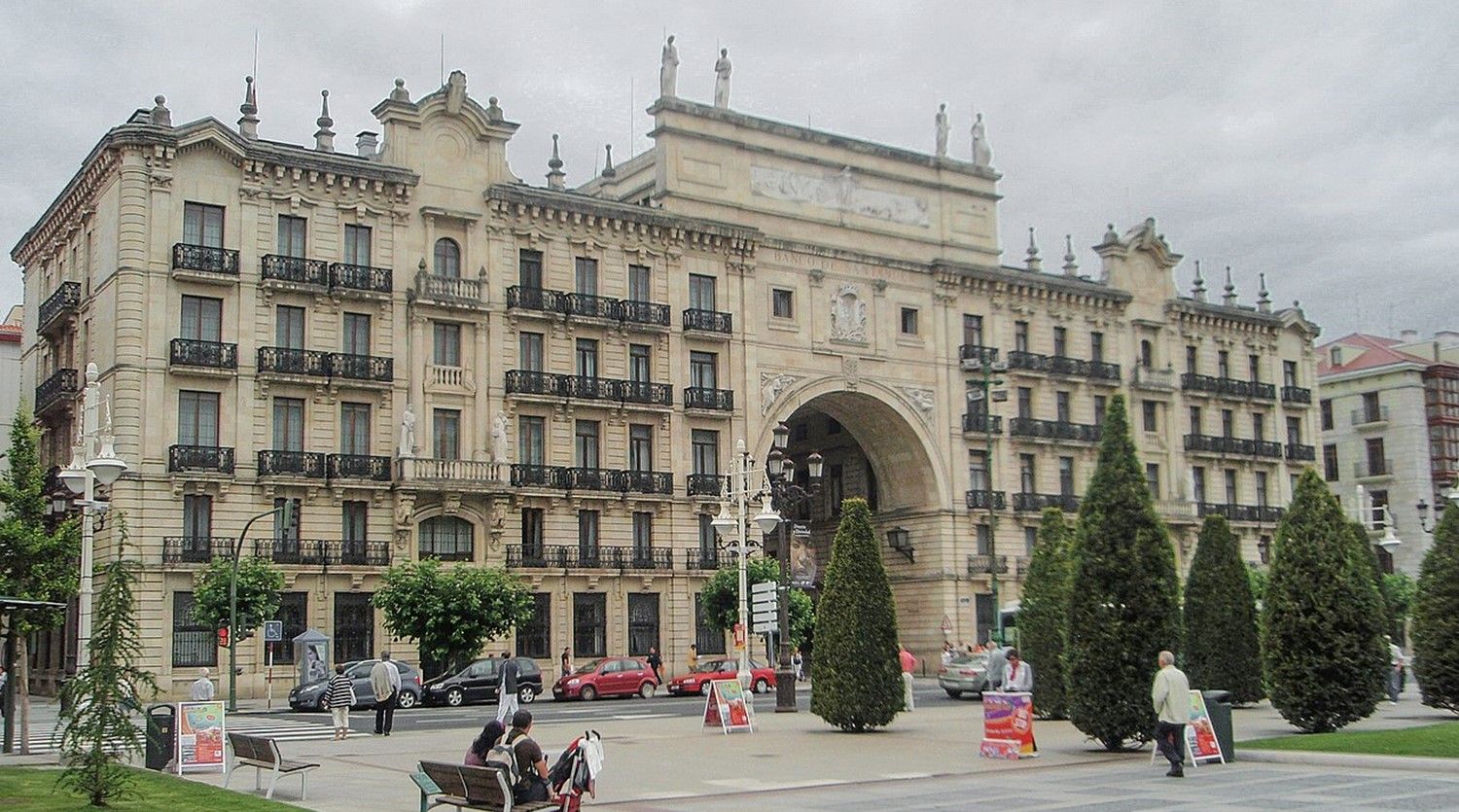
Banco de Santander is the largest bank in Spain and the 37th biggest public company in the world, with 186,000 employees, 14,392 branches, 102 million customers and €3.9trillion in 'assets under custody', whatever that means. In 2004, looking to break into the booming, highly profitable British banking sector, it bought the London-based Abbey National Bank. Later, following the 2008 great financial crash, it bought up the nearly bust Alliance & Leicester bank and the branch network of the completely bust and nationalised Bradford & Bingley bank. All three were demutualised building societies that had become intoxicated by the ‘fast buck’ financial culture of the nineties and noughties and came to grief. By 2010 Santander UK had over 1,000 branches in UK, the largest branch network of any bank in the country.
The original Abbey habit
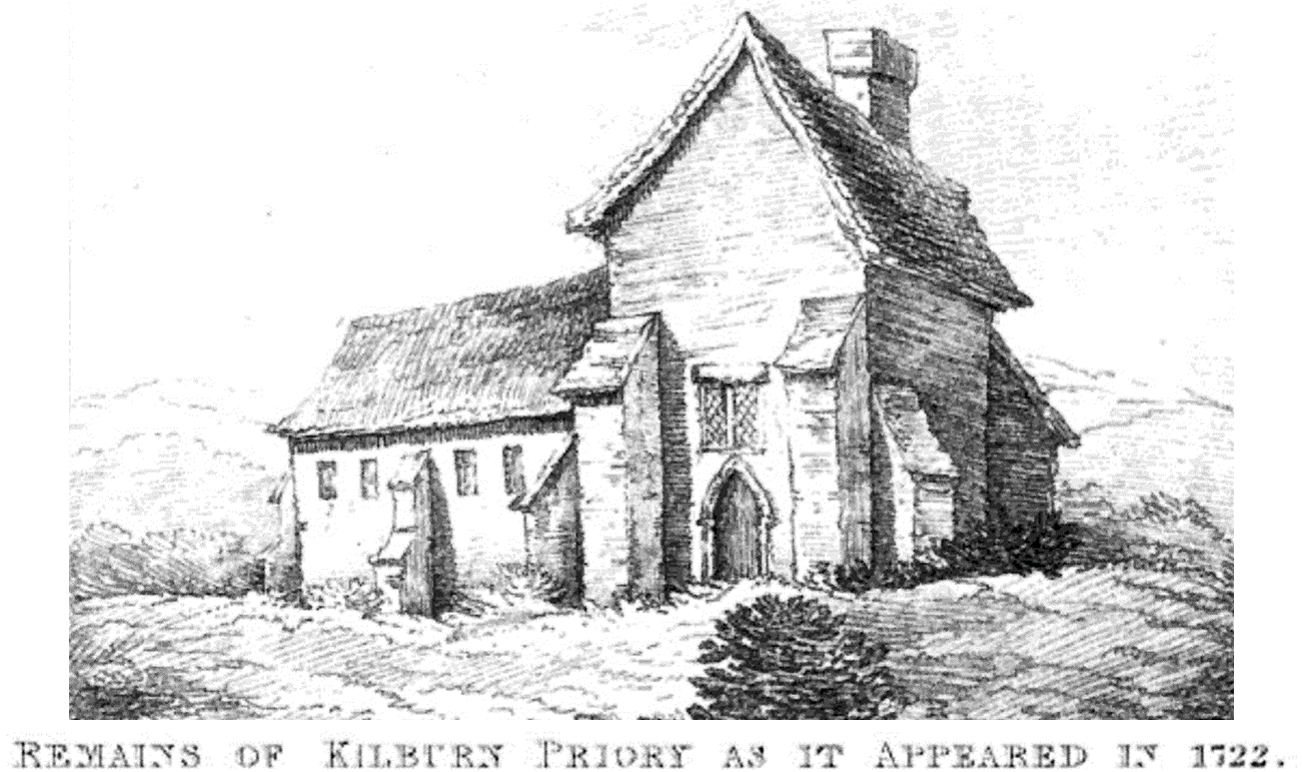
Abbey National is familiar to most older people as the go-go building society that in the 1970s and 1980s revolutionised the staid mutual sector, under its General Manager Clive Thornton. It pioneered bright shop-like branches, and invested massively in advertising its mortgage and savings products. In 1989 it became the first building society to ‘demutualise’ and become a for-profit bank, Abbey National plc. This move sparked the demutualisation goldrush which was such a feature of the building society sector in the 1990s.
The history of the building society is worth telling. The Abbey Road and St John’s Wood Mutual Benefit Building Society was set up in 1874 by members of the local free church. That’s the same Abbey Road that later became famous for the EMI recording studios and a certain zebra crossing used by The Beatles in 1969. The abbey the road leads to is Kilburn Priory, founded in 1128 by Queen Matilda as a place of retirement for three of her ladies-in-waiting, and dissolved in 1537 by King Henry VIII. The site is now occupied by the Priory Tavern, which just happens to be one of my favourite pubs.
The National Permanent Mutual Building Society was founded in 1852 as a vehicle for the National Freehold Land Society, whose purpose was to allow ordinary workers to be able to buy a plot of land which would entitle them to the vote. At that time, only men owning land with a rateable value of over £2 per year could vote. Having bought 13 estates in areas around London for this purpose, in 1858 it founded a company, British Land, to build houses on them. This subsidiary became the company that is now British Land plc, with a property portfolio worth £11bn which includes the Meadowhall shopping centre in Sheffield and the Cheesegrater skyscraper in the City of London, mentioned in the previous episode of Walker’s Wanderings.
The Abbey and the National building societies merged in 1943 with the specific purpose of creating a powerful entity capable of financing very large amounts of new housing as part of the post-war reconstruction. For better or worse, Abbey National was a key institution in the establishment of ‘the housing ladder’ and ever-rising house prices as the new English national religion.
The headquarters of Abbey National were at Abbey House, 219-229 Baker Street, London. For many years, until a little museum was opened to give them what they were looking for, puzzled tourists would arrive at the front desk looking for Sherlock Holmes’s fictional flat at 221B Baker Street.
All this remarkable history of 19th and 20thcentury mutualism and co-operative enterprise was, as our current Prime Minister would put it, spaffed up the wall during the demutualisation frenzy of the 1990s that Abbey National started in 1989.
Santander’s other acquisitions, Bradford & Bingley and Alliance & Leicester, also have long and regionally-important histories as mutual societies dating back to the 1850s (Alliance having previously been the Brighton and Sussex building society). Sadly there isn’t space to tell them here. The Alliance & Leicester demutualised in 1997, and the more traditionalist Yorkshiremen of Bradford & Bingley followed in 2000. Both were destroyed by their managements within 12 years.
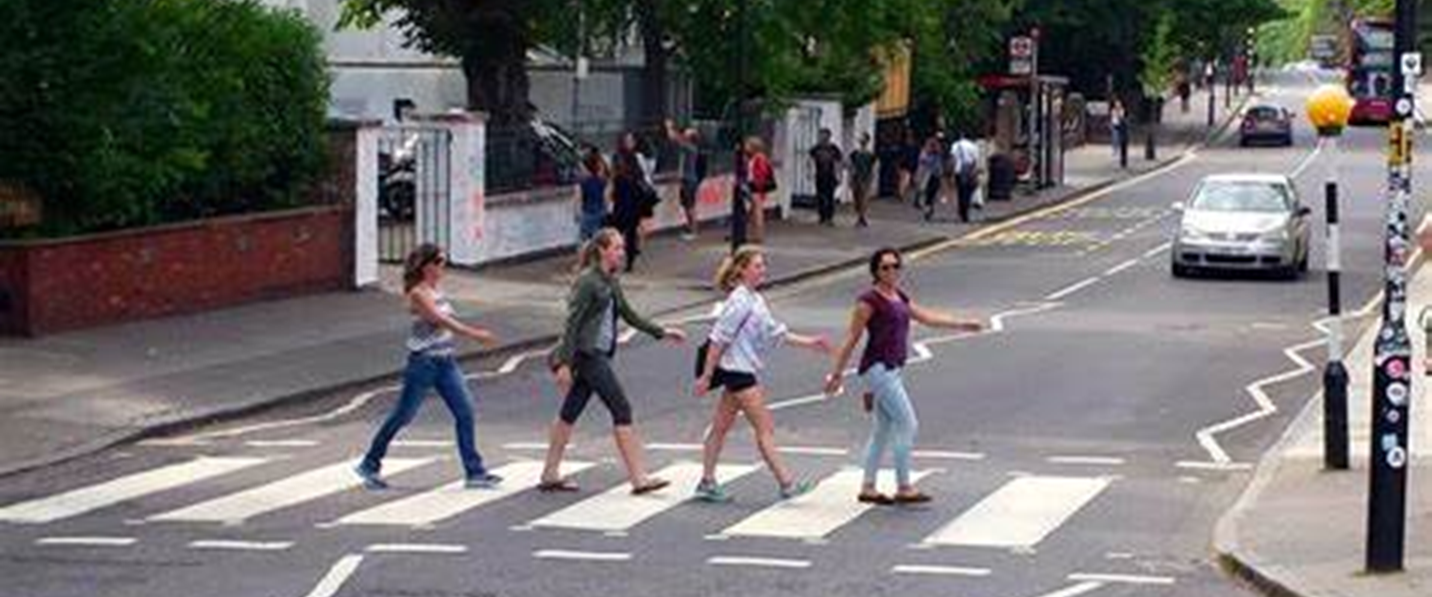
The demutualisation years
Anyone with a building society savings account had a vote on whether to keep their society mutually-owned or take a so-called ‘windfall’ payment of several hundred pounds to sell their stake. Huge majorities voted to take the cash. I had an Alliance & Leicester savings account, and I remember voting not to demutualise, but, when I was outvoted, taking the cash anyway.
The managements of these new for-profit banks, now no longer working for their savers and borrowers, quickly got to work making that money back from them. The business model was to use pressure sales methods to persuade customers visiting branches to do their everyday banking to buy various financial and insurance ‘products’ that, shall we say, the bank understood rather better than the typical customer, and benefitted the bank rather more than they benefitted their purchaser. The nadir of this approach was payment protection insurance (‘PPI’), which basically degenerated into a long-running fraud perpetrated by the banks on their customers.
The branch network was the crucial component in the scam. Get the aura right, of a welcoming friendliness matched with a kind of swish seriousness, and the more branches it had, the more money a bank would make. It is hard to imagine now, in the era of 0.1% interest rates and the general disinterest of the banks in drumming up custom via the High Street, but there was a time when planners were getting concerned that so many high street premises were being taken over by banks that it was damaging the balance of the retail ecosystem. They were the chicken shops or nail bars of the noughties.
It was all over by 2010 when Santander came on the scene. The profitable action in the mortgage game moved from branches to the internet, and the last decade has seen the inexorable decline of branch banking. Formerly bright and buzzy branches in high streets across the country have increasingly had the distinct air of institutions well past their prime.
The funny thing is however, that until lockdown started, it was something of a golden age for branch banking in person. A high level of service was provided for free. The staff were usually pleased to see a customer and the pressure to flog financial products had gone off the boil. I used to firmly refuse to accept enticements to move my transactions online with the answer “because I like coming in here to see you!” It was never going to last and coronavirus has now killed it off.
Urbi et orbi: an Easter message

So there we have it - a sad tale. But Easter is all about death and resurrection. 110 small towns and suburbs may yet rise again.
The political and economic era that began with the Thatcherite concepts of rewards to risk-taking and entrepreneurialism, matured into the fraud and chaos of the 2007/08 financial crash, and lived on as a zombie through the 2010s must surely finally be dead now. The next era is up for grabs. One path is a new era which harks back to the pre-Victorian system of inherited wealth, political clientelism, grotesque corruption and inequality.
However, hope springs eternal and it is appropriate to end on a positive note. At Empowering Our Communities, hosted by Civic Revival and Democracy4Bexhill, Preston City Council's leader Matthew Brown not only indicted the British banking sector for its complete failure to provide a service to locally-rooted small businesses, including co-operatively-owned businesses, he showed us the way out of the mess with the approach known as community wealth building.
The North West Mutual Bank has been set up by Preston City Council working with Wirral Borough Council in Liverpool City Region. It has recently received its banking licence and is gearing up to launch. Its mission and purpose speak for themselves and are copied in full below. Like building societies before them, it’s a model that can be rolled out in any place – and this is exactly what is happening, with new banks also being set up in the West of England with Avon Mutual and North of the Tyne with the North East Peoples Bank (as reported by Civic Revival here).
These banks may at last provide the integrity of service to local savers and wealth-generating enterprises that the big banks have been failing to provide for the last 20 years or more. Can we dream that they will in time open branches and become trusted staples of many a thousand urban villages and their communities in the years to come?
North West Mutual – mission statement
Our team. We're building a team of people to create a new, ethical, trustworthy, customer owned bank serving all the people, small businesses and local organisations of the North West of England.
Our mission. The bank’s focus will be serving the needs of the North West region, providing a safe, ethical and supportive bank which will, keep savings safe, lend to businesses that are creating jobs and invest in high quality sustainable homes by driving improvement in housing and home ownership. Helping to create and store community wealth.
Our purpose. To exclusively support the North West's economy and its people. We will aim to work for current and future generations through the provision of honest, accessible, ethical and locally rooted banking services. We will support the priorities of the North West by being based in the region, understanding the needs of the region and creating jobs by investing in businesses who are growing and helping ordinary people own a home. North West Mutual will ensure that customers can make their money work harder for them over time, will help them to achieve their realistic home ownership plans and help them save well for the future and for retirement. It will always have their back.
The 110 Santander branches to close June-August 2021
Sites to be shut plus addresses and date of planned closure:
- Arnold 84 Front Street, Arnold NG5 7EJ 12 August 2021
- Ashby-de-la-Zouch 24 Market Street, Ashby-de-la-Zouch LE65 1AL 29 July 2021
- Ashford Church Road 30 Church Road, Ashford TW15 2UY 5 August 2021
- Balham High Road 200 Balham High Road, London SW12 9DH 24 June 2021
- Banstead High Street 79 High Street, Banstead SM7 2NL 1 July 2021
- Barking 37 Station Parade, Barking IG11 8EB 12 August 2021
- Beckenham 212-214 High Street, Beckenham BR3 1EN 12 August 2021
- Bethnal Green 450 Bethnal Green Road, Bethnal Green E2 0HG 15 July 2021
- Bingley Main Street 155 Main Street, Bingley BD16 1AJ 1 July 2021
- Birmingham Erdington 112 High Street, Erdington B23 6RS 29 July 2021
- Bishopsgate 224 Bishopsgate, London City EC2M 4AN 24 June 2021
- Blaby 9 Crossways House, Blaby LE8 4DD 1 July 2021
- Bletchley 24 The Concourse, Brunel Centre, Bletchley MK2 2DL 8 July 2021
- Bramhall 3 Woodford Road, Bramhall SK7 1JN 5 August 2021
- Brighouse Commercial Street 26 Commercial Street, Brighouse HD6 1AQ 15 July 2021
- Brighton London Road 16 London Road, Brighton BN1 4HY 1 July 2021
- Bristol Bedminster 95 East Street, Bedminster BS3 4HA 29 July 2021
- Camberwell 34 Denmark Hill, Camberwell SE5 8RZ 29 July 2021
- Castleford Carlton Street 51 Carlton Street, Castleford WF10 1AN 29 July 2021
- Catford 162 Rushey Green, Catford SE6 4JT 8 July 2021
- Cheadle 16 High Street, Cheadle SK8 1AJ 8 July 2021
- Chelsea Kings Road 138 Kings Road, Chelsea SW3 4XB 8 July 2021
- Chester-Le-Street 57-59 Front Street, Chester-le-Street DH3 3DD 8 July 2021
- Chingford Old Church Road 35 Old Church Road, Chingford E4 6SJ 1 July 2021
- Chiswick 336 Chiswick High Road, Chiswick W4 5TL 15 July 2021
- Chorlton-cum-Hardy 575 Wilbraham Road, Chorlton-cum-Hardy M21 9AB 8 July 2021
- Clifton Whiteladies Road 107 Whiteladies Road, Bristol BS8 2PB 15 July 2021
- Cobham 13 High Street, Cobham KT11 3DH 12 August 2021
- Cosham 81 High Street, Cosham PO6 3BL 12 August 2021
- Coulsdon 138 Brighton Road, Coulsdon CR5 2XR 29 July 2021
- Dagenham 247 Heathway, Dagenham RM9 5BG 15 July 2021
- Dalkeith 25-27 High Street, Dalkeith EH22 1LD 22 July 2021
- Dalston 86 Kingsland High Street, Dalston E8 2PG 12 August 2021
- Darwen 10-11 Market Street, Darwen BB3 1DN 12 August 2021
- Dewsbury 12 Northgate, Dewsbury WF13 1DT 12 August 2021
- Dudley Merryhill Merryhill Centre, Dudley DY5 1SY 24 June 2021
- Edinburgh Morningside Road 356 Morningside Road, Edinburgh EH10 4TE 29 July 2021
- Enfield Hertford Road 199 Hertford Road, Enfield EN3 5JH 5 August 2021
- Finchley High Road 760 High Road, Finchley N12 9QH 24 June 2021
- Fulham 421 North End Road, Fulham SW6 1NY 5 August 2021
- Glasgow Kilmarnock Road 110 Kilmarnock Road, Shawlands G41 3NN 8 July 2021
- Glasgow Sauchiehall Street 147 Sauchiehall Street, Glasgow G2 3EW 24 June 2021
- Gosforth 129-131 High Street, Gosforth NE3 1HG 29 July 2021
- Grays 30 High Street, Grays RM17 6LU 29 July 2021
- Halesowen 9 Hagley Street, Halesowen B63 3AS 22 July 2021
- Hanover Square 14a Hanover Square, London W1S 1JL 1 July 2021
- Harborne High Street 182-184 High Street, Harborne B17 9PP 5 August 2021
- Harold Hill 69 Farnham Road, Harold Hill RM3 8XA 22 July 2021
- Harpenden 31a High Street, Harpenden AL5 2RU 22 July 2021
- Hatfield 11 Town Centre, Hatfield AL10 0NY 1 July 2021
- Hayes Station Road 16 Station Road, Hayes UB3 4DY 8 July 2021
- Haywards Heath 37-39 South Road, Haywards Heath RH16 4LQ 1 July 2021
- Hempstead Valley 27 Hempstead Valley Shopping Centre, Gillingham ME7 3PQ 24 June 2021
- High Holborn 306a High Holborn, London WC1V 7JZ 8 July 2021
- Hinckley 6 Castle Street, Hinckley LE10 1DB 29 July 2021
- Horsforth 42 Town Street, Horsforth LS18 4AP 5 August 2021
- Hounslow Bath Road 388 Bath Road, Hounslow TW4 7HT 15 July 2021
- Huyton 57 Derby Road, Huyton L36 9YA 8 July 2021
- Hyde Market Place 11 Market Place, Hyde SK14 2NP 15 July 2021
- Leatherhead 2 High Street, Leatherhead KT22 8HT 12 August 2021
- Leeds Crossgates 59-61 Station Road, Crossgates LS15 8DT 15 July 2021
- Leicester Horsefair Street Permanent House, Horsefair Street, Leicester LE1 5BJ 15 July 2021
- Leicester Narborough Road 256 Narborough Road, Leicester LE3 2AP 8 July 2021
- Leigh-on-Sea 85 The Broadway, Leigh-on-Sea SS9 1PN 5 August 2021
- Letchworth 12-14 Central Approach, Letchworth SG6 3DJ 5 August 2021
- Leytonstone 662 High Road, Leytonstone E11 3BD 12 August 2021
- London Bridge 9 Southwark Street, London SE1 1RQ 15 July 2021
- Long Eaton 79 High Street, Long Eaton NG10 1GE 5 August 2021
- Lytham Clifton Street 75 Clifton Street, Lytham St Annes FY8 5ER 22 July 2021
- Margate 110-112 High Street, Margate CT9 1JR 22 July 2021
- Marlow 37 High Street, Marlow SL7 1XA 1 July 2021
- Mill Hill 45 The Broadway, Mill Hill NW7 3DJ 15 July 2021
- Moorgate 48-54 Moorgate, London EC2R 6EJ 1 July 2021
- Morecambe 42 Euston Road, Morecambe LA4 5DD 5 August 2021
- Nelson The Centre, Nelson BB9 9SX 29 July 2021
- New Malden 132 High Street, New Malden KT3 4HY 22 July 2021
- Newcastle-under-Lyme 58 High Street, Newcastle-under-Lyme ST5 1QE 15 July 2021
- Norbury 1424 London Road, Norbury SW16 4EP 1 July 2021
- Oadby 38 The Parade, Oadby LE2 5BF 22 July 2021
- Oxford Headington 116 London Road, Oxford OX3 9AS 12 August 2021
- Petts Wood 97 Queensway, Petts Wood BR5 1SG 5 August 2021
- Pinner 27 Bridge Street, Pinner HA5 3JW 8 July 2021
- Plymstock 9 Dean Hill, Plymstock PL9 9AA 5 August 2021
- Poulton-le-Fylde 18 Market Place, Poulton-le-Fylde FY6 7AS 12 August 2021
- Putney 88-90 Putney High Street, Putney SW15 1RB 29 July 2021
- Rickmansworth 107-109 High Street, Rickmansworth WD3 1EG 1 July 2021
- Runcorn 12 Orchard Walk, Runcorn WA7 2BS 1 July 2021
- Sale 46 School Road, Sale M33 7XE 22 July 2021
- Shepherds Bush 23 Shepherds Bush Green, London W12 8PH 22 July 2021
- South Harrow 285-287 Northolt Road, Harrow HA2 8JS 22 July 2021
- Southampton Bitterne Road 424 Bitterne Road, Southampton SO18 1BS 5 August 2021
- Southampton Shirley 1 Shirley High Street, Southampton SO15 3TE 8 July 2021
- Southgate 6 Chase Side, Southgate N14 5NY 22 July 2021
- Strand 406 Strand, London WC2R 0NE 24 June 2021
- Surbiton 12 Victoria Road, Surbiton KT6 4JW 29 July 2021
- Swinton 143 Chorley Road, Swinton M27 4AE 1 July 2021
- Syston 1262 Melton Road, Syston LE7 2HB 24 June 2021
- Twickenham 1 King Street, Twickenham TW1 3SD 1 July 2021
- Upper Edmonton 163 Fore Street, Upper Edmonton N18 2UX 29 July 2021
- Walkden 33 Bolton Road, Walkden M28 3AX 24 June 2021
- Wallasey 14 Liscard Village, Wallasey CH45 4JW 22 July 2021
- Welling 14 Bellegrove Road, Welling DA16 3PP 22 July 2021
- Wembley Preston Road 223 Preston Road, Wembley HA9 8XD 29 July 2021
- West Wickham 30 High Street, West Wickham BR4 0SN 15 July 2021
- West Worthing 37 Goring Road, Worthing BN12 4AR 15 July 2021
- Weybridge 9 High Street, Weybridge KT13 8ED 15 July 2021
- Wibsey 9 Folly Hall Road, Wibsey BD6 1UL 24 June 2021
- Wickford 18A High Street, Wickford SS12 9AZ 8 July 2021
- Windsor 97 Peascod Road, Windsor SL4 1AZ 5 August 2021
- Winton 330 Wimborne Road, Winton BH9 2HP 22 July 2021
